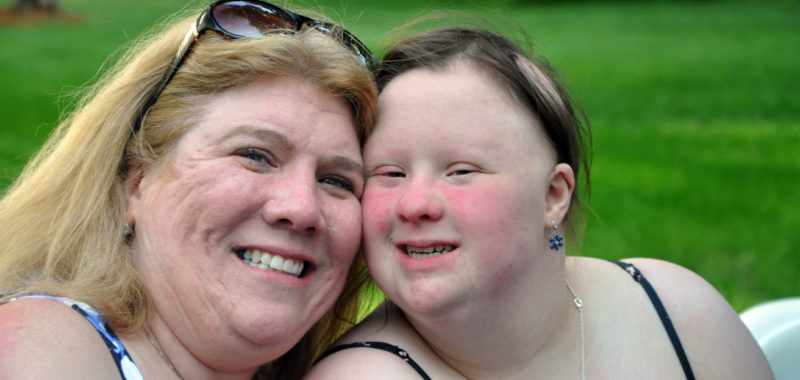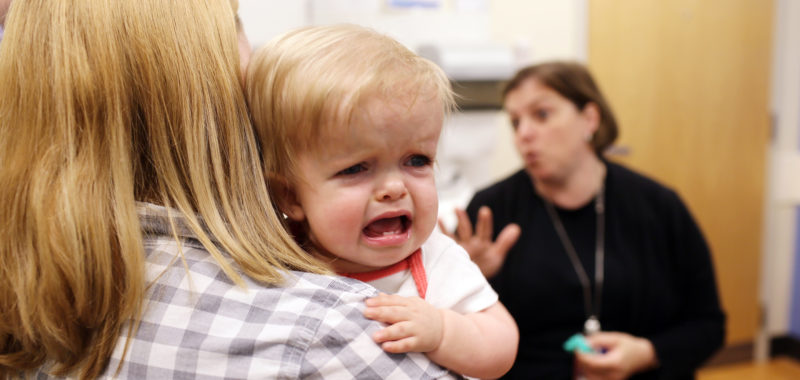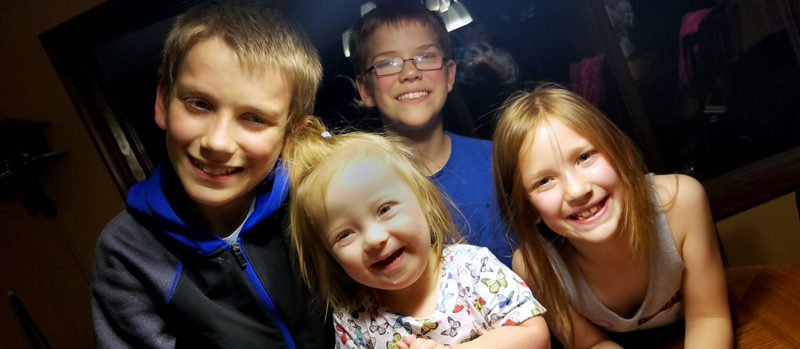My daughter, Jordan, is 18 years old and will be attending a post-secondary program in the fall. While this might sound like a typical path some students take, it is an achievement I wasn’t sure she would be able to attain just a couple of years ago.
Jordan has Down syndrome and like many children and teens with the condition, she also has chronic obstructive sleep apnea (OSA). This condition can cause sleep problems – including not breathing for short periods of time. Most children with Down syndrome will develop sleep apnea between the ages 9-11 and if left untreated, can lead to behavioral problems, delayed growth, and in extreme cases, heart failure. The American Academy of Pediatrics recommends sleep studies for children with Down syndrome as early as age 4 or 5.
Most children with Down syndrome have OSA because the structural features in their face can include narrow passageways in the face and throat, enlarged tongue, adenoid and tonsils, and low muscle tone in the mouth and upper airway – all potentially leading to obstruction of the airway.
Jordan was diagnosed with obstructive sleep apnea syndrome at age 15 by her doctor in our hometown of Boston. And as a result, as a family we weren’t getting much sleep. Jordan wasn’t sleeping well for obvious reasons and I was constantly worried that she wasn’t breathing. I would listen for snoring and go into her room in the middle of the night and roll her over whenever I heard it.
So we needed a solution and our first treatment option for OSA was the CPAP machine, or continuous positive airway pressure, to keep her airway open at night.
Let me say that this option was not without its challenges. It took us six months to find a mask that worked, because they’re not made for children with structural differences in their faces. Once we did find one that fit – and when I say “fit” I mean that it wasn’t perfect but we were able to modify it to not only work but be comfortable for her to sleep. At first with the mask on, she slept right through the night and woke refreshed. Jordan was so resilient and just accepted she needed to wear this. We were relieved but of course with anything new, there can be set backs– we were not prepared for the level of involvement the machine would require at night. She needed assistance putting it on before bed, she needed to be coaxed and encouraged to wear the mask and she would inadvertently take it off in the middle of the night. (I have to assume because it was so uncomfortable!) Some nights she was fine and kept it on and sometimes it would be turned off and off her face. We found ourselves in the same situation where no one was really sleeping well.
As I started doing research and looking for other options, I became concerned about her being on CPAP long-term. Yearly EKGs would be required as well as regular sleep studies to evaluate any changes. This machine added an additional level of care that would be needed by a provider as she continued to age. And to be honest, it wasn’t working that well for us in the first place. Jordan’s sleep was still being interrupted and she needed a lot of help from us in the middle of the night.
One of our biggest goals for Jordan is to help her become more independent. We wanted her to be able to go away to school, maybe eventually live somewhat on her own and to have a good quality of life. We felt like the CPAP machine, along with the support needed, was a step in the opposite direction.
But some of the surgical options I read about for OSA terrified me. One of our top-notch surgeons in Boston had an option for jaw surgery, with a three-month recovery time and a liquid diet. We wanted a way to treat her sleep apnea without undergoing a surgical procedure that would put her out of commission for multiple months. She was entering her junior year of high school and months of recuperation could possibly cause her to lose a year of high school.
Through my continued research I was given Dr. Sally Shott’s name and eventually heard her speak at a national conference about other options for kids with craniofacial abnormalities and obstructive sleep apnea. We liked what we heard so we gathered all of her x-rays and records and eventually made our way to Cincinnati Children’s Complex Obstructive Sleep Apnea Center to see her.
After a thorough evaluation Dr. Shott recommended that Jordan undergo a lingual tonsillectomy (removal of the lingual tonsils in the back of the throat), partial midline glossectomy (reduction of the base of the tongue) and a genioglossus advancement (base of tongue pulled forward to increase the size of the airway). She explained what all of those were, got out her pen and paper, and drew pictures to illustrate for us. She introduced us to her entire team that would be helping Jordan.
I still had a lot of questions and she broke things down for us in simple terms and answered every inquiry to my satisfaction. Will she be able to taste food? Will it damage her tongue and her nerves, arteries and taste buds? Will it help with her drooling problem? How much will it affect her teeth? (We had spent thousands of dollars in orthodonture work!) Will it impede her ability to use her tongue – to sing and eat? Will it affect her sinus cavity?
And my biggest question was about recovery time. I was shocked when she told me that she would spend six days in Cincinnati and then would be back to school in another week. Two weeks total recovery time? No liquid diet AND Jordan would be back in time to make her junior prom? Their team was confident, relaxed and quite competent with their recommendations. Jordan was not an experiment, but a regular patient, who happened to have Down syndrome.
We were having a hard time seeing a down side. We scheduled the procedures for April 2014 and a year or so later, Jordan is doing fantastic. She is off CPAP!! She has more energy. She’s not snoring at night. She’s since been in two musicals at school. She attended her senior prom. And because she hasn’t needed us at night, she’s regained her independence. She is now headed to attend a post-secondary program at Berkshire Hills Music Academy in the fall.
Jordan is the most resilient human being. She works harder just to get a quarter of what her non-disabled peers get. I am a better parent, wife, advocate and friend because of Jordan. She teaches me more than I will ever be able to teach her. I’m looking forward to next phase of Jordan’s life and am happy she and the rest of the family will be well rested for it.

Editor’s note: On July 23, 2015, we hosted a live Q&A event about options for chronic obstructive sleep apnea in children who have Down syndrome, Pierre Robin syndrome and micrognathia. Drs. Raouf Amin and Stacy Ishman answered participants’ questions live on video stream. Watch the broadcast here.






Cheryl- this is a very well written article. Hopefully, it will help other parents and children who face similar issues. You have succeeded in keeping Jordan on a path on normalcy. You were a fine advocate. I commend you on a job well done. I look forward to hearing about her new ventures as she starts a new phase of life in a month or two. Aunt Mary